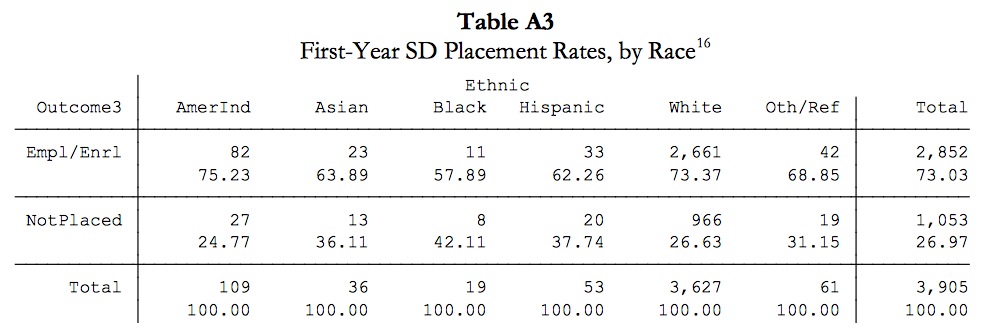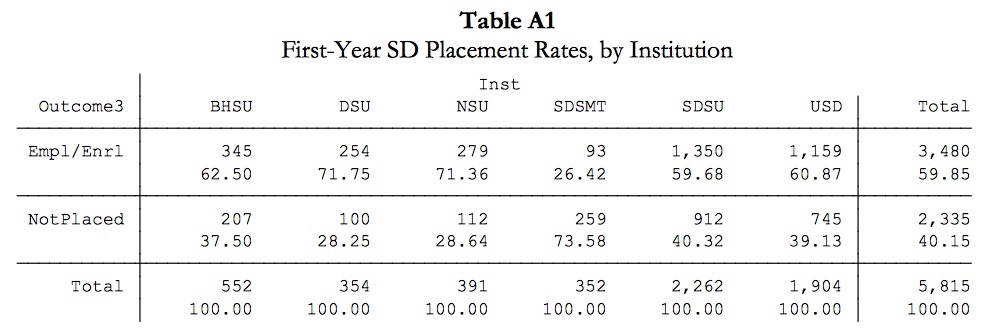Last updated on 2014.11.28
Some trivia from the South Dakota Board of Regents placement outcomes report:
1. The racial group with the highest rate of placement in jobs or ongoing education in South Dakota: American Indians.

Compare cautiously a sample of 82 Indians with a sample of 2,661 whites. But let's me optimistic: get more Indians to university, get them to graduate, and they'll put their skills to work in South Dakota as surely as the rest of the graduate population.
2. The sex with better in-state placement: women.

The Regental report does not clarify whether more women than men are actually going to work or grad school or whether this ten-point gap in placement indicates that more men leave the state for work than women.
3. The best campus for first-year in-state placement: Dakota State. The worst: School of Mines.

Of course DSU has a high in-state placement rate: it lives and breathes as the training school for Citibank and Premier Bankcard.
School of Mines advertises a 98% placement rate for its graduates. Mines graduates also fetch some of the best starting salaries in the country. A School of Mines placement brochure lists 119 employers who hired 2011–2012 Mines grads. Mines marks 21 of those employers as South Dakota employers. That supports the conclusion we might draw from the numbers above that encouraging students to go into science and engineering does not immediately translate into benefits for South Dakota's economy.
Update 2014.11.28 10:43 CST: School of Mines communications manager Fran LeFort responds to my inquiry about these states with this note:
It is worth noting a significant number of our graduates are hired by companies in the region and may still contribute economically to the state. Some of these companies are just outside the borders of South Dakota – Wyoming coal mines, North Dakota oil fields, Nucor in Norfolk, Neb., etc. [Fran LeFort, e-mail, 2014.11.26]
Note that every Regental institution may be able to make a similar claim. An analysis of regional placement on top of state placement might be interesting, but I have a feeling that telling legislators, "Hey, look how much our programs are boosting Minnesota's workforce!" won't rouse much cheering.

Women usually get stuck working for less. Hence, SD is the place for them!
Mostly related: Why does the Santee Sioux tribal nation pay liquor taxes to the state?
http://www.moodycountyenterprise.com/v2_news_articles.php?heading=0&page=73&story_id=5514
KINDA RELATED TOO.
[T]he configuration that renders massacres as battles, battles as wars, and wars as just, conveys ... a kind of historical lie that Americans would also do well not to forget.
For in all such acts of forgetting is instigated an even more subtle but violent act of erasure.
The monument dedicated to the Sand Creek Massacre sits low to the ground, like a tombstone on the bluff above the place where Black Kettle’s band was camped. Engraved with a Native figure—a caricature really, adorned in a feathered headdress—we are now beyond a time when the words, “SAND CREEK BATTLE GROUND” can be read without irony.
The granite monument ... was placed by local citizens on Aug. 6, 1950.... The site was part of a private ranch at the time.
... physical anchors of memory call out from the darkness and demand to be known. And they must be. Not simply or even primarily to condemn historical violence, but to overcome the tyranny of silence and forgetfulness that conspires to forestall healing and inhibit the sense of empathy that is essential to a shared understanding of the past.
http://www.salon.com/2014/11/29/our_thanksgiving_responsibility_native_americans_honest_history_and_the_simple_power_of_remembrance/